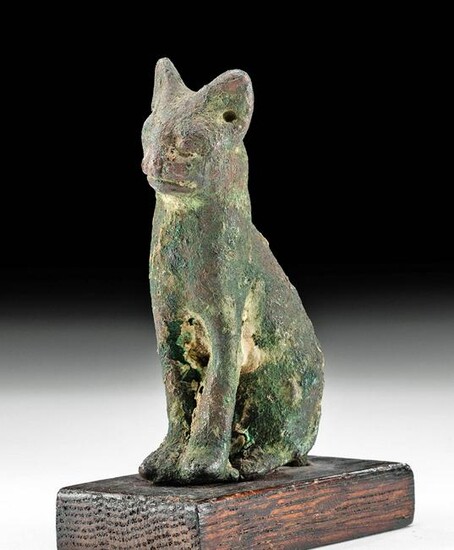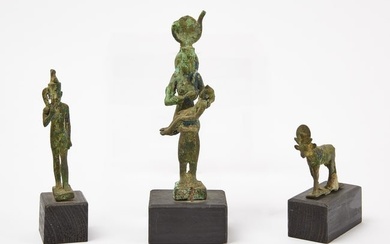Egyptian Bronze Seated Figure of a Cat
Egypt, Late Dynastic to Ptolemaic Period, ca. 664 to 30 BCE. An exquisite cast-bronze figure of a cat of an instantly recognizable Egyptian style, seated upon its plump haunches with its sinuous tail wrapped around its hind legs and fore paws. The seated feline relaxes with its back gently arched and its chest protruding forward in a patient, defensive pose with its weight leaned over the front legs as if ready to strike at the first mouse it sees. The head rests atop a tapered neck and features a charming countenance defined by almond eyes, a tapered snout, a thin mouth with lightly impressed corners, and a pair of pierced ears. Cats were some of the most important and highly symbolic animals in Egyptian mythology, and figures like this were perhaps created as votive offerings to the Bastet, the goddess of cats or Sekhmet, the lioness-headed goddess of war. Gorgeous areas of brown, green, and russet patina have formed across the composition. Size: 1.875" L x 1.1" W x 3.375" H (4.8 cm x 2.8 cm x 8.6 cm); 3.7" H (9.4 cm) on included custom stand.
The ancient Egyptians, rather uniquely among the world's civilizations, had an obsession with cats, both tame and fierce, large and small. Cats were domesticated to help protect crops from pests in Cyprus or possibly Mesopotamia (it is difficult to interpret the archaeological record on this matter for a variety of reasons), but the Egyptian love of cats seems to have gone above and beyond that of their contemporaries. The cemetery at Hierakonpolis includes a cat skeleton in a pre-Dynastic tomb (ca. 3700 BCE) that had a broken left humerus and right femur that seem to have been set by a human and allowed to heal before that cat's ultimate death. The first illustration of a cat with a collar comes from a 5th Dynasty (ca. 2500 to 2350 BCE) Egyptian tomb at Saqqara. Cats were the most frequently mummified animal in Egypt and there were multiple feline goddesses, including the domesticated cat-form Bastet.
Bastet was initially a lioness goddess associated with the solar god and channeled its destructive power. However, by the early first millennium BCE, she assumed a more domestic feline form and became understood as a goddess of fertility and a guardian of the home. Ever since, statuettes comprised of various materials have characterized her as a doting mother cat. Her cult expanded decisively when her town in Bubastis (derived from per Bastet or "house of Bastet"), became the royal residence of the kings of the 22nd Dynasty, during the 10th century BCE. The city hosted an annual festival honoring Bastet in celebration of the Nile flood waters, and she was honored throughout Egypt through the first millennium BCE.
For a strikingly similar example, please see The Metropolitan Museum of Art, accession number 66.99.145.
Provenance: private Toronto, Ontario, Canada collection, by descent, acquired in Egypt in 1894 to 1896
All items legal to buy/sell under U.S. Statute covering cultural patrimony Code 2600, CHAPTER 14, and are guaranteed to be as described or your money back.
A Certificate of Authenticity will accompany all winning bids.
PLEASE NOTE: Due to recent increases of shipments being seized by Australian & German customs (even for items with pre-UNESCO provenance), we will no longer ship most antiquities and ancient Chinese art to Australia & Germany. For categories of items that are acceptable to ship to Australia or Germany, please contact us directly or work with your local customs brokerage firm.
Display stands not described as included/custom in the item description are for photography purposes only and will not be included with the item upon shipping.
#167152
Condition Report: Minor abrasions and softening to finer details, with sea encrustations and barnacles within some recessed areas, and nicks to tail, back tang, head, ears, and body, otherwise intact and very good. Mottled green, brown, and russet patina throughout.
View it on
Sale price
Estimate
Time, Location
Auction House
Egypt, Late Dynastic to Ptolemaic Period, ca. 664 to 30 BCE. An exquisite cast-bronze figure of a cat of an instantly recognizable Egyptian style, seated upon its plump haunches with its sinuous tail wrapped around its hind legs and fore paws. The seated feline relaxes with its back gently arched and its chest protruding forward in a patient, defensive pose with its weight leaned over the front legs as if ready to strike at the first mouse it sees. The head rests atop a tapered neck and features a charming countenance defined by almond eyes, a tapered snout, a thin mouth with lightly impressed corners, and a pair of pierced ears. Cats were some of the most important and highly symbolic animals in Egyptian mythology, and figures like this were perhaps created as votive offerings to the Bastet, the goddess of cats or Sekhmet, the lioness-headed goddess of war. Gorgeous areas of brown, green, and russet patina have formed across the composition. Size: 1.875" L x 1.1" W x 3.375" H (4.8 cm x 2.8 cm x 8.6 cm); 3.7" H (9.4 cm) on included custom stand.
The ancient Egyptians, rather uniquely among the world's civilizations, had an obsession with cats, both tame and fierce, large and small. Cats were domesticated to help protect crops from pests in Cyprus or possibly Mesopotamia (it is difficult to interpret the archaeological record on this matter for a variety of reasons), but the Egyptian love of cats seems to have gone above and beyond that of their contemporaries. The cemetery at Hierakonpolis includes a cat skeleton in a pre-Dynastic tomb (ca. 3700 BCE) that had a broken left humerus and right femur that seem to have been set by a human and allowed to heal before that cat's ultimate death. The first illustration of a cat with a collar comes from a 5th Dynasty (ca. 2500 to 2350 BCE) Egyptian tomb at Saqqara. Cats were the most frequently mummified animal in Egypt and there were multiple feline goddesses, including the domesticated cat-form Bastet.
Bastet was initially a lioness goddess associated with the solar god and channeled its destructive power. However, by the early first millennium BCE, she assumed a more domestic feline form and became understood as a goddess of fertility and a guardian of the home. Ever since, statuettes comprised of various materials have characterized her as a doting mother cat. Her cult expanded decisively when her town in Bubastis (derived from per Bastet or "house of Bastet"), became the royal residence of the kings of the 22nd Dynasty, during the 10th century BCE. The city hosted an annual festival honoring Bastet in celebration of the Nile flood waters, and she was honored throughout Egypt through the first millennium BCE.
For a strikingly similar example, please see The Metropolitan Museum of Art, accession number 66.99.145.
Provenance: private Toronto, Ontario, Canada collection, by descent, acquired in Egypt in 1894 to 1896
All items legal to buy/sell under U.S. Statute covering cultural patrimony Code 2600, CHAPTER 14, and are guaranteed to be as described or your money back.
A Certificate of Authenticity will accompany all winning bids.
PLEASE NOTE: Due to recent increases of shipments being seized by Australian & German customs (even for items with pre-UNESCO provenance), we will no longer ship most antiquities and ancient Chinese art to Australia & Germany. For categories of items that are acceptable to ship to Australia or Germany, please contact us directly or work with your local customs brokerage firm.
Display stands not described as included/custom in the item description are for photography purposes only and will not be included with the item upon shipping.
#167152
Condition Report: Minor abrasions and softening to finer details, with sea encrustations and barnacles within some recessed areas, and nicks to tail, back tang, head, ears, and body, otherwise intact and very good. Mottled green, brown, and russet patina throughout.





